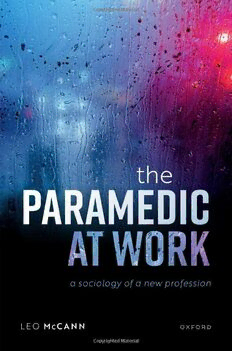Table Of ContentTheParamedicatWork
The Paramedic at Work
ASociologyofaNewProfession
Leo McCann
GreatClarendonStreet,Oxford,OX26DP,
UnitedKingdom
OxfordUniversityPressisadepartmentoftheUniversityofOxford.
ItfurtherstheUniversity’sobjectiveofexcellenceinresearch,scholarship,
andeducationbypublishingworldwide.Oxfordisaregisteredtrademarkof
OxfordUniversityPressintheUKandincertainothercountries
©LeoMcCann2022
Themoralrightsoftheauthorhavebeenasserted
Impression:1
Allrightsreserved.Nopartofthispublicationmaybereproduced,storedin
aretrievalsystem,ortransmitted,inanyformorbyanymeans,withoutthe
priorpermissioninwritingofOxfordUniversityPress,orasexpresslypermitted
bylaw,bylicenceorundertermsagreedwiththeappropriatereprographics
rightsorganization.Enquiriesconcerningreproductionoutsidethescopeofthe
aboveshouldbesenttotheRightsDepartment,OxfordUniversityPress,atthe
addressabove
Youmustnotcirculatethisworkinanyotherform
andyoumustimposethissameconditiononanyacquirer
PublishedintheUnitedStatesofAmericabyOxfordUniversityPress
198MadisonAvenue,NewYork,NY10016,UnitedStatesofAmerica
BritishLibraryCataloguinginPublicationData
Dataavailable
LibraryofCongressControlNumber:2021952511
ISBN978–0–19–881636–2
DOI:10.1093/oso/9780198816362.001.0001
Printedandboundby
CPIGroup(UK)Ltd,Croydon,CR04YY
LinkstothirdpartywebsitesareprovidedbyOxfordingoodfaithand
forinformationonly.Oxforddisclaimsanyresponsibilityforthematerials
containedinanythirdpartywebsitereferencedinthiswork.
Preface
There had been warnings about this for decades. Risk assessments and
preparednessauditsburieddeepinforgottenfilestores.Principles,proce-
dures, and colour-coded flowcharts describing the likely trajectories of a
deadlynewdiseasepandemic.AgovernmentsimulationinOctober2016,
known as Exercise Cygnus, roleplayed the response of healthcare, local
government,police,fireandrescue,andmilitaryorganizationstoaflu-like
disease outbreak. It found major shortages and deficiencies in the pan-
demicresponse,withthehealthserviceoverwhelmed.Itpredicted400,000
deaths. The findings of Cygnus were deemed ‘too terrifying’ for public
consumptionandthereportwasinitiallysupressed.1
Justoverthreeyearslateradangerousnewvirusbrokeoutforreal.The
SARS-CoV-2virushittheUKextremelyhard,acrossthreegiantwavesof
infectioninthespringof2020,theautumn/winterof2020–2021,andagain
in the autumn/winter of 2021-2022. The National Health Service came
closetobeingoverwhelmedinthefirsttwopeaks.Atthetimeofwriting
therehavebeenmorethanfifteenmillioninfectionsandover15,000deaths
attributedtotheCovid-19disease.
Working conditions for almost all people were upended by regional
and national lockdowns, travel bans, and social distancing measures; by
bankruptcy and closure of facilities; and by job cuts and staff sickness
absence.Healthcarewasoneofthemosttraumatic,exhausting,andrisky
work environments imaginable. Frontline healthcare professionals of all
kinds, as well as support, logistical, and administrative staff, had little or
nooptionofworkingfromhome.Instead,theycontinuedworkingatthe
heartofadreadfulandprolongedcrisis.Newsmediatendedtofocusmost
oftheirattentiononhospitalsandonthedoctors,nurses,andotherclin-
icianstreatingcriticallyillpatientsinspecialistCovid-19isolationwards.
Thehospitalbecameasceneofdesperatebleakness.Staffwereshatteredby
theworkload,waryoftheextremeriskofcontractingthevirusthemselves,
1‘ExerciseCygnusuncovered:thepandemicwarningsburiedbythegovernment’,TheTelegraph,28
March2019.
vi Preface
and emotionally drained by constant trauma coupled with the unbear-
ablelonelinessimposedbyisolationmeasures.Patientsweresufferingand
dyingwithoutthecomfortoflovedonesatthebedside.
Amodernhealthcaresystemisbroadandcomplex,encompassingmany
other professions and sites. The clinical workers who are the focus of
thisbookworkoutinthecommunity,operatingina‘pre-hospital’work-
ingenvironmentthatisatoncecomplex,dynamic,uncertain,andpoorly
understood.ClearlythefirstUK-widelockdownofMarch–July2020was
extremely challenging for frontline paramedics and for ambulance ser-
vices,especiallythecrisisthatenvelopedcarehomes.But,asthepandemic
evolved, some elements of working life for ambulance crews were not
quite as dreadful as first feared. Paramedics and ambulance services felt
the impacts of the Covid-19 pandemic in ways that were distinct and
idiosyncratic.Thegeneralpopulationwasextremelycautious,heedingthe
government message to stay indoors and massively restricting interper-
sonal contact. Members of the public were especially reluctant to go to
hospital, and thought long and hard before calling 999 and running the
risk of being taken there by an ambulance crew. The broader NHS had
alsopostponedorcancelledallnon-urgentconsultationsandprocedures,
turningmostoftheirattentiontoCovidpatients.Everydayactivitiesthat
often result in people getting injured or sick happened much less often.
Therewerefarfewerroadtrafficaccidents.Therewerenoentertainmentor
sportseventsforwhichemergencyserviceswouldprovidebackup.There
werenocalloutstodrunksortopeoplewithinjuriesfromfighting.Even
the psychiatric calls dropped off in volume; many of those often driven
by anxiety or depression to call 111 or 999 found ways to suppress that
tendency.
Ambulances were mostly being dispatched, therefore, to Covid-related
calls that were ‘genuine’ emergencies. Emergency funding provided for
extra crews on shift, and some locations had support from the Fire and
Rescue Service and the Army. Ambulance stations were busy with staff
waitingforcalls,meaningthat—unusually—therewastimeforstaffinter-
action,toshareadvice,andto‘decompress’afterstressful andexhausting
shifts. Each individual crew didn’t receive as many calls as they usually
would,butwhenacalldidcomein,itwastypicallyseriousandchallenging.
Patientstreatedbyparamedicstendedtobeverysickindeed.Therewere
thousandsofcallstopatientsstrickenwithlife-threateningCovid-related
conditionssuchaspneumonia,hypoxia,andheartattacks.Forashorttime,
thechangedrhythmandactivityduringthepandemicremindedcrewsof
Preface vii
‘theolddays’;12-hourshiftsfeaturingonlyaroundfourorfivecallouts,but
eachtoapatientfacingagenuinelydangeroushealthemergency.2
The first lockdown was eventually successful in suppressing infection
rates,hospitalizations,anddeaths,andUKsocietystartedtoreopeninJuly
2020. But, predictably enough, the rates of Covid infection slowly crept
back up throughout late summer and accelerated in autumn. With win-
teronthehorizon,thehealthcareeconomywasbuildingtowardsdisaster.
By January 2021, the country was back into a lockdown almost as severe
as the first one in March 2020. Covid-19 infection rates exploded, peak-
ingataround60,000knowninfectionsperday.Hospitalswereonceagain
overwhelmed with coronavirus patients. Over a thousand Covid patients
were dying every day. Calls to ambulance services now hit record lev-
els, such as 8,500 calls per day to London Ambulance Service, instead of
the usual 5,000–6,000.3 All around the country, ambulances were stuck
in long queues outside hospitals, unable to offload Covid patients for
hours because of a lack of available beds inside. Hospitals had tried to
keep routine and elective appointments going, only dropping this work-
loadtoaccommodatethesecondwavewhentheyhadnootherchoice.The
‘normal’ calls to the ambulance service didn’t drop off. The more recent
lockdownwaslessstrictlyadheredtothanthefirst.Thepopulationwasalso
stressed,isolated,andexhaustedbyninemonthsoflifeinapandemic,so
thementalhealthcallscameback.Virusoutbreaksoccurredwithinambu-
lancecontrolcentresandHQs,leadingtoprolongedillness,staffshortages,
andworkoverload.Thistimearound,noneoftheparamedicsoutonthe
streetsweremakingallusionsto‘thegoodolddays’.Instead,theywere,in
thewordsofparamedicandauthorJakeJones,‘frustrated,drained,[and]
powerlesstohelp’.⁴
Concerns started to circulate about the probable inadequacy of the
personal protective equipment (PPE) issued to ambulance crews. It con-
sistedofLevel2PPEtobeworntoallcalls(surgicalfacemask,disposable
gloves,andapron),andLevel3PPE(FFP3maskorrespiratorhood,fluid
repellentoveralls)tobeusedwhencrewscarryout‘aerosolgeneratingpro-
cedures’suchaschestcompressions.OneparamedicdescribedLevel2to
2Anofficialoverviewofthepandemicfromtheperspectiveofambulanceserviceemployersis
AACE(2021).Forapersonalblogfromaparamedic,see‘Onthefrontline’,UKClimbing,14April
2020,availableat:https://www.ukclimbing.com/articles/features/on_the_front_line-12718
3‘LondonAmbulanceService:‘Wetakethousandsofcallsaday–it’stough’,BBCNews,18January
2021.
⁴‘EvenastheCovidcrisisaccelerates,paramedicslikemeseepeopletakingrisks’,TheGuardian6
January2021.
viii Preface
me as little more than ‘a plastic pinny you’d use for making sandwiches’.
ParamedicswereseatedwithCovid-infectedpatientsintheconfinedspace
ofanambulanceinterior,waitingforhoursatatimeashospitalsstruggled
tofindspacetoadmitnewpatients.Staffwerewarnednottobreakproto-
colandupgradethemselvestoLevel3insuchsituations.Doingsoinany
casewouldoftenseeminappropriateandwouldoffendaparamedic’sun-
derstandingofappropriatepatienttreatment—respiratorsorhoodsmake
interactionextremelydifficult,withoneparamediccommentingonTwit-
ter that the Level 3 gear in use in his Trust makes the wearer look like
Darth Vader.⁵ Many broke the rules and donned the gear. Some resorted
tobuyingtheirownFFP3masksfromScrewfix.
By October 2020, around 1 in 12 paramedics had tested positive for
Covid-19andbyJanuary2021,atleast18frontlineambulanceworkersin
the UK had died of the disease.⁶ Mercifully, ambulance staff were finally
inoculatedbytheendofJanuary2021,withvaccinesprovidingawayout
ofthenightmarethatthey,andotherNHSstaff,hadsufferedforsolong.
Thevaccinesdidnotfullypreventnewinfections,butwereveryeffective
inbreakingthelinkbetweeninfectionandseriousillness.Afurther,pro-
longedwaveofinfectionintheautumnandwinterof2021waslesssevere
thantheprevioustwo.Thevirusbecameendemic,andalargelyvaccinated
society learnt to adapt to live with it without lockdowns and social dis-
tancing measures. Still, the NHS as a whole faced a terrible backlog of
postponed patient care, and found itself facing drastic operational diffi-
culties throughout the year even before it headed into its always-difficult
wintermonths.⁷
Iwroteabouthalfofthisbookduringtheyears2020–21.Ihadplanned
to finish it long before 2020, and the research data upon which it is
based predate the Covid-19 pandemic by several years. But I had to
reflectonthesecontemporaryeventssomewhereinthetext.Evenwithout
the pandemic, a central theme of the book was of professionals fac-
ing stress and burnout, and of trying to serve the public in extremely
trying circumstances and with limited support. Already struggling with
⁵Tweetby@ClipboardUK,3January2021,availableat:
https://twitter.com/ClipboardUK/status/1345893679244963841?s=20
⁶TraceyNicholls,ChiefExecutiveoftheUKCollegeofParamedics,toRtHonMattHancock,Secre-
taryofStateforHealthandSocialCare,January6,2021.Availableat:https://www.collegeofparamedics.
co.uk/COP/News/Rtcollege_of_paramedics_writes_to_the_rt_hon_matt_hancock_regarding_PPE_
for_paramedics.aspx
⁷‘Hospitalsturningambulancesawayasdemandsoars,A&Echiefsays’,TheGuardian,25September
2021;‘Livesatriskfromlongambulancewaits,sayparamedics’,BBCNews,11November2021.
Preface ix
whatisademanding,exhaustingandprofessionallyunderappreciatedrole,
paramedicsfoundthemselvesinthegripofapublichealthcrisisofdisas-
trousproportions.Theyhadtodigdeeptofindyetanotherwellofenergy,
resilience, and goodwill. Somehow they found it. Ambulance staff work-
ingdayandnightduringthepandemicplayedacriticalroleincaringfor
peopleindireneed,justastheyalwayshavedoneandcontinuetodo.This
bookisdedicatedtothem.

